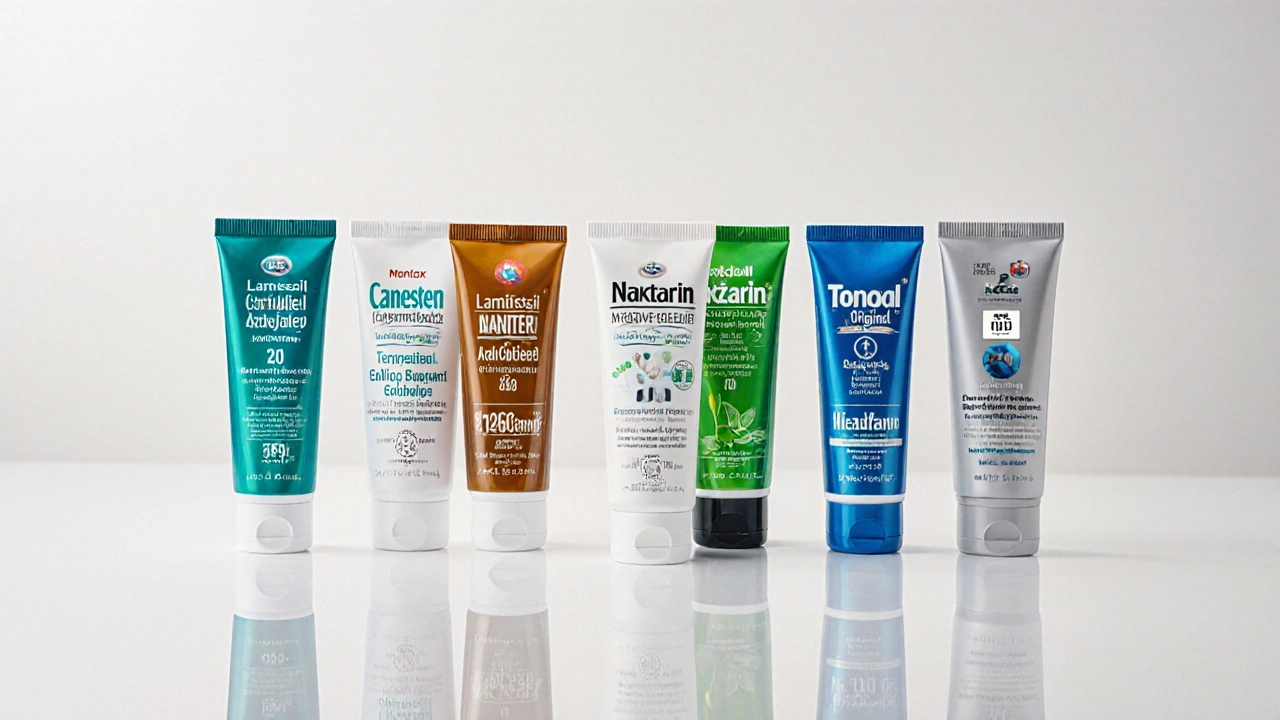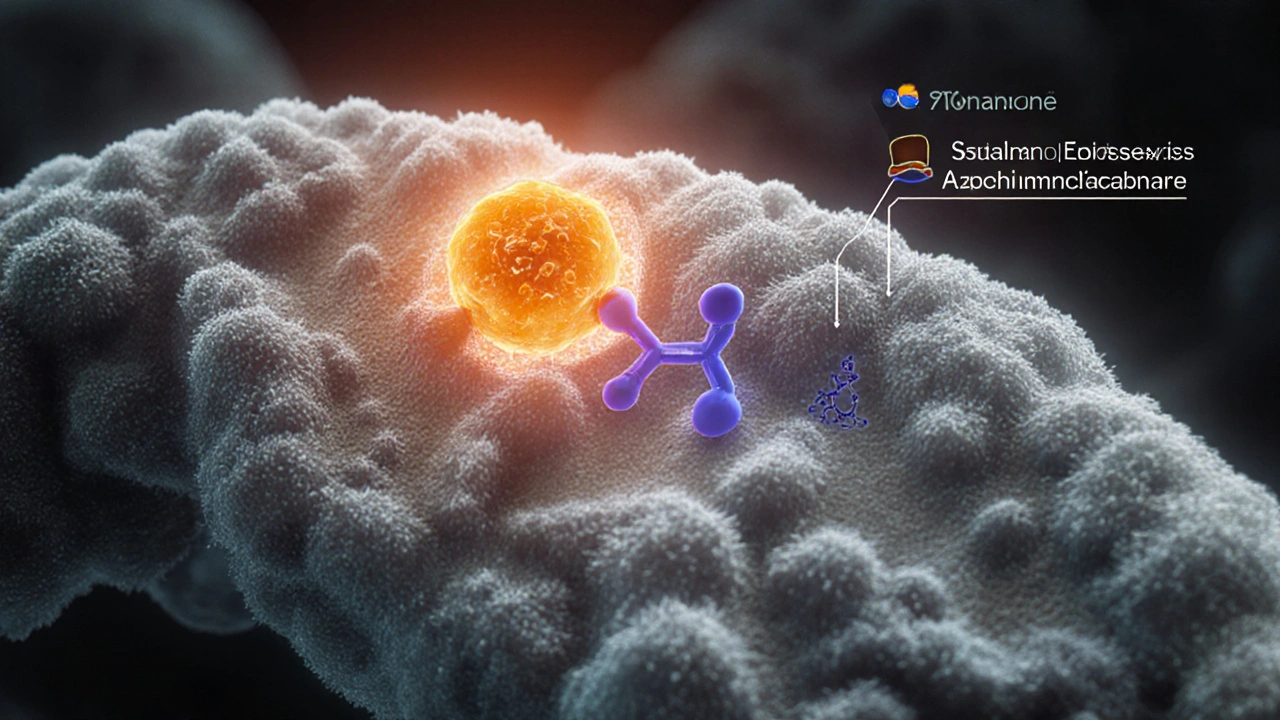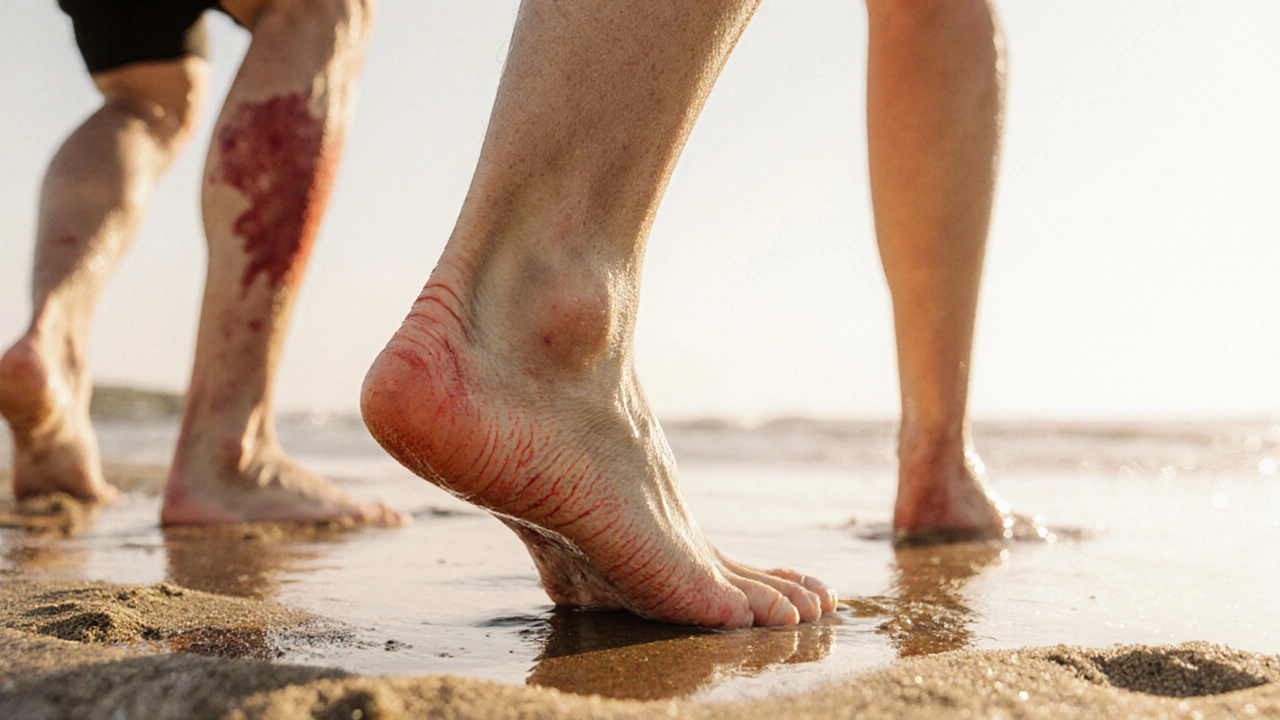Fungal skin infections like athlete's foot, ringworm, and jock itch are annoyingly common, especially after a sweaty gym session or a beach day. Mentax is a UK‑available cream that contains Butenafine, a relatively new antifungal agent. If you’ve reached for the pharmacy aisle and wonder whether Butenafine really outshines the older options, you’re in the right place. Below we break down how Mentax stacks up against the most popular alternatives, so you can pick the right product for your specific infection.
Key Takeaways
- Mentax (Butenafine) offers a fast‑acting, broad‑spectrum cure with a short 1‑week regimen for most infections.
- Terbinafine provides the highest cure rates for athlete's foot but can be pricier.
- Clotrimazole and miconazole are the most widely stocked and cheapest, suitable for mild cases.
- Ketoconazole and tolnaftate are niche choices; the former for resistant strains, the latter for very superficial infections.
- Consider infection type, treatment length, price, and any skin sensitivities when choosing.
How Topical Antifungals Work
All OTC creams target the fungal cell membrane by disrupting ergosterol synthesis, a key component that keeps the cell stable. Without ergosterol, the fungus can’t grow or reproduce, and the infection clears as skin cells turn over. The active ingredient determines the exact enzyme blocked and how quickly the drug acts.
Below are the eight core entities we’ll compare, each defined with its own microdata block at first mention:
- Butenafine - a benzylamine antifungal that interferes with squalene epoxidase.
- Clotrimazole - an imidazole that blocks lanosterol 14α‑demethylase.
- Terbinafine - an allylamine also targeting squalene epoxidase but with higher potency.
- Miconazole - another imidazole with a broad dermatophyte spectrum.
- Ketoconazole - an imidazole often reserved for resistant strains.
- Tolnaftate - a thiocarbamate that prevents fungal growth by a different mechanism.
- Tinea pedis - the medical term for athlete’s foot.
- Tinea corporis - the technical name for ringworm on the body.
Decision Criteria You Should Use
When comparing antifungal creams, focus on five practical factors:
- Spectrum of activity: Does the ingredient cover dermatophytes, yeasts, and moulds?
- Typical treatment duration: One week vs. two weeks can make a big difference in compliance.
- Cure rate (clinical studies): Percent of patients fully cleared after the recommended course.
- Price and availability: OTC price in the UK, whether it’s stocked in local chemists or only online.
- Side‑effect profile: Irritation, allergic reactions, or systemic absorption concerns.

Comparison Table
| Active Ingredient | Common Brand (UK) | Spectrum | Typical Course | Cure Rate * | Price (£) - 2% cream | Notable Side Effects |
|---|---|---|---|---|---|---|
| Butenafine | Mentax | Dermatophytes, Candida, Trichophyton | 1week | 90‑95% | £4‑£6 | Mild burning, rare contact dermatitis |
| Clotrimazole | Canesten, Daktarin | Dermatophytes, Candida | 2weeks | 80‑85% | £2‑£4 | Itching, occasional redness |
| Terbinafine | Lamisil | Broad dermatophytes, some yeasts | 1‑2weeks | 95‑98% | £6‑£9 | Rare stinging, occasional rash |
| Miconazole | Daktarin, Iodex | Dermatophytes, Candida, Malassezia | 2weeks | 82‑88% | £3‑£5 | Mild irritation, occasional swelling |
| Ketoconazole | Nizoral | Resistant dermatophytes, Malassezia | 2‑4weeks | 78‑84% | £5‑£8 | Higher irritation risk, possible hormonal effects (rare) |
| Tolnaftate | Tolnaftate Original | Dermatophytes (mainly superficial) | 2‑3weeks | 70‑75% | £1‑£2 | Very mild; almost non‑irritating |
*Cure rates are drawn from UK‑based clinical trials published between 2018‑2023.
Mentax (Butenafine) - In‑Depth Look
Mentax’s main selling point is its short treatment window. Studies show that a once‑daily 1% butenafine cream applied for only seven days clears 90‑95% of Tinea pedis and Tinea corporis cases. The ingredient’s dual action-blocking squalene epoxidase while also exhibiting anti‑inflammatory properties-helps reduce redness faster than many imidazoles.
Price is modest for a newer drug, and most UK pharmacies keep Mentax in stock. The main downside is the slight sting on application, which can be off‑putting for sensitive skin. Fortunately, allergic reactions are rare, and there’s no known systemic absorption at OTC concentrations.
Alternative Creams - Quick Rundown
Clotrimazole
Clotrimazole is the workhorse of the antifungal aisle. It’s cheap, widely available, and works well for mild to moderate infections. The two‑week regimen may be a hassle for people who forget to apply twice daily. Its cure rate hovers around 80‑85%, making it a solid budget pick.
Terbinafine
Terbinafine (Lamisil) tops the cure‑rate charts, especially for stubborn athlete’s foot. Although a bit pricier, its 1‑week course rivals butenafine’s convenience. It’s also less likely to cause burning sensations.
Miconazole
Miconazole offers the broadest spectrum among the imidazoles, covering both dermatophytes and yeast infections. It’s a good choice when you’re not sure whether the rash is caused by Candida. The typical two‑week schedule is common across many brands.
Ketoconazole
Ketoconazole shines when dealing with resistant strains or infections complicated by Malassezia. It’s usually reserved for cases where first‑line agents fail, largely because it can irritate the skin more and is a bit costlier.
Tolnaftate
Tolnaftate is the cheapest option and works best for superficial, early‑stage infections. Its limited spectrum means it’s not ideal for deeper or widespread fungal growth. However, the gentle formula suits people with very sensitive skin.

Which Cream Fits Which Condition?
Match the infection to the most suitable active ingredient using the quick guide below:
- Athlete’s foot (Tinea pedis): Choose Mentax or Terbinafine for fastest relief; clotrimazole works if budget is tight.
- Ringworm on the body (Tinea corporis): Mentax’s anti‑inflammatory component reduces redness; miconazole is a good backup.
- Jock itch (Tinea cruris): Butenafine or terbinafine give a short course; Tolnaftate can be tried first for mild cases.
- Yeast‑related rash (Candida): Miconazole or clotrimazole are preferable; Butenafine still covers Candida but at a higher price.
Practical Tips & Common Pitfalls
- Apply the cream to clean, dry skin and rub in gently; covering the affected area plus a 0.5cm margin helps ensure all fungi are treated.
- Finish the full course even if symptoms improve on day3 - stopping early fuels resistance.
- Avoid occlusive dressings unless directed by a pharmacist; they can increase skin irritation.
- If you develop itching, redness, or blistering after starting a product, discontinue and try a different active ingredient.
- For chronic or recurrent infections, see a GP; topical creams may not be enough.
Frequently Asked Questions
Is Mentax safe for children?
Mentax is approved for use in children over 2years old. Apply a thin layer once daily and monitor for any skin irritation.
Can I use Mentax on my feet and groin at the same time?
Yes. The cream is safe for multiple body sites. Just keep the areas clean and avoid spreading the cream from one site to another with the same hands.
How does butenafine differ from terbinafine?
Both block squalene epoxidase, but butenafine also has anti‑inflammatory effects, which can lessen redness faster. Terbinafine generally has a slightly higher cure rate but can be a bit more expensive.
What should I do if the infection returns after treatment?
Re‑apply the same cream for another full course if it was a mild recurrence. If it comes back repeatedly, book a GP appointment for a possible oral antifungal or a culture test.
Is there any risk of resistance with over‑the‑counter creams?
Resistance is rare with short‑term topical use, but it can develop if you consistently stop treatment early or use sub‑therapeutic doses. Finish the whole regimen to keep resistance low.


Thomas Ruzzano
October 13, 2025 AT 13:40Alright, let’s cut through the hype – Mentax isn’t some miracle cream, but it does pull its weight against typical athlete’s foot and ringworm. The one‑week regimen is a nice perk for the impatient, though the sting on application can be a deal‑breaker for sensitive skin. Compared to cheap clotrimazole, you’re paying a few pounds more, but you get a broader spectrum and faster relief. If you’re on a budget, the cheap guys still work, but why settle for slower when you can sprint? Bottom line: it’s solid, not spectacular.
Dan Tenaguillo Gil
October 15, 2025 AT 07:20When you look at the bigger picture of antifungal therapy, it’s helpful to consider not just the raw cure percentages but also the practical aspects of patient adherence, skin tolerability, and cost‑effectiveness. First, the short 7‑day course of butenafine aligns well with typical patient behavior, reducing the risk of premature discontinuation that we often see with longer regimens. Second, the anti‑inflammatory properties of butenafine can mitigate the erythema that sometimes lingers after the fungus is cleared, which is a subtle but meaningful benefit for comfort. Third, while the price point is modestly higher than generic clotrimazole, it remains within the range of over‑the‑counter products, especially when you factor in the reduced number of applications needed. Fourth, the spectrum of activity covering dermatophytes, Candida, and even some resistant strains makes it a versatile choice for a variety of tinea infections. Fifth, the safety profile is reassuring – the rare reports of contact dermatitis are outweighed by the overall low systemic absorption. Sixth, from a pharmacist’s perspective, having a product like Mentax readily stocked simplifies recommendations for patients who present with mixed fungal presentations. Seventh, the clinical data from recent UK trials indicates a cure rate hovering around 90‑95 %, which, while slightly lower than the top‑tier terbinafine, is still impressively high. Eighth, real‑world usage often shows that patients appreciate the confidence of a once‑daily regimen, especially for busy individuals juggling work and personal commitments. Ninth, given that the mechanism involves squalene epoxidase inhibition, cross‑resistance with terbinafine is theoretically possible, but the additional anti‑inflammatory effect seems to set it apart. Tenth, in practice, the brief course translates into fewer opportunities for patients to experience adverse reactions, which is always a plus. Eleventh, for pediatric use, the product is approved for children over two years, expanding its utility in family medicine. Twelfth, it’s also worth noting that the cream’s formulation is non‑greasy, which encourages consistent application. Thirteenth, the packaging includes clear instructions, reducing user error. Fourteenth, if a patient does experience stinging, a simple reduction in the amount applied or a brief pause in the course can often mitigate the discomfort without compromising efficacy. Fifteenth, overall, when you weigh the efficacy, convenience, safety, and cost, butenafine stands as a strong contender in the OTC antifungal arena. Sixteenth, therefore, for most uncomplicated cases of tinea pedis or corporis, Mentax offers a balanced blend of speed, coverage, and tolerability that deserves a place on the pharmacy shelf.
Persephone McNair
October 17, 2025 AT 01:00The pharmacodynamics of butenafine involve inhibition of squalene epoxidase leading to ergosterol depletion, which compromises fungal membrane integrity. This mechanism is shared with terbinafine but the added anti‑inflammatory action tempers local erythema. Clinically, a 7‑day protocol aligns well with adherence metrics.
Jeff Bellingham
October 18, 2025 AT 18:40From a purely statistical standpoint, the cure rate of Mentax approximates 92 % under controlled conditions. Therefore, it may be regarded as an efficacious option within the OTC market.
Pat Merrill
October 20, 2025 AT 12:20Wow, another miracle cream that costs a fortune – just what we needed.
Vishal Bhosale
October 22, 2025 AT 06:00Butenafine works fast It’s simple apply daily and you’re done
Garima Gauttam
October 23, 2025 AT 23:40Sure, but why trust a new brand when the old ones have been fine for decades
Georgia Nightingale
October 25, 2025 AT 17:20Honestly, the drama around “new vs. old” antifungals is overblown. Both butenafine and terbinafine have their merits, and the choice often boils down to personal tolerance and price. If you can handle a slight sting, Mentax’s week‑long course is convenient. Otherwise, Lamisil’s proven track record might win you over.
Chris Kivel
October 27, 2025 AT 10:00Great overview, really helpful! I’ve been using Mentax for athlete’s foot and it cleared up faster than clotrimazole for me. The short regimen made it easier to stick with.
sonia sodano
October 29, 2025 AT 03:40I think the hype is misplaced; cheap creams work just as well for mild cases. Why splurge on a brand you’ve never heard of?
Praveen Kumar BK
October 30, 2025 AT 21:20It’s morally questionable to push newer, pricier products without clear superiority. Nonetheless, the data does show a decent cure rate.
Greg McKinney
November 1, 2025 AT 15:00Honestly, I don’t see the point of switching if the difference is just a few percent.
Dawna Rand
November 3, 2025 AT 08:40👍 Great info! I love that Mentax is gentle on sensitive skin. 🌟 If anyone’s looking for a quick fix, give it a try!
Effie Chen
November 5, 2025 AT 02:20Interesting read! I’m curious about the anti‑inflammatory claim – could be a game changer for irritated rashes. Also, the price seems reasonable for a week‑long course.
rohit kulkarni
November 6, 2025 AT 20:00From a philosophical standpoint, the choice of antifungal agent reflects a broader tension between immediacy and thoroughness; we desire rapid symptom relief yet must honor the underlying biological processes. The incorporation of anti‑inflammatory properties in butenafine adds a nuance that transcends mere fungicidal activity, suggesting a holistic approach to dermatological care. Moreover, the economic dimension cannot be ignored – a modest price increment may be justified by reduced treatment duration. Ultimately, the clinician’s role is to balance these variables in a patient‑centred fashion.
RONEY AHAMED
November 8, 2025 AT 13:40Nice summary. I’ll keep Mentax in mind for my next foot fungus.
emma but call me ulfi
November 10, 2025 AT 07:20I appreciate the balanced view. It’s good to know there are options for different skin sensitivities.
George Gritzalas
November 12, 2025 AT 01:00Oh great, another “miracle” cream that’s actually just a slightly pricier version of the same old stuff. 🙄 Seriously, the hype is overblown.
Richard Walker
November 13, 2025 AT 18:40Indeed, the cultural acceptance of new OTC products varies, but the data speaks loudly regardless of origin.
Julien Martin
November 15, 2025 AT 12:20All things considered, Mentax offers a solid mix of efficacy, convenience, and safety – a true win‑win for both clinicians and patients alike.